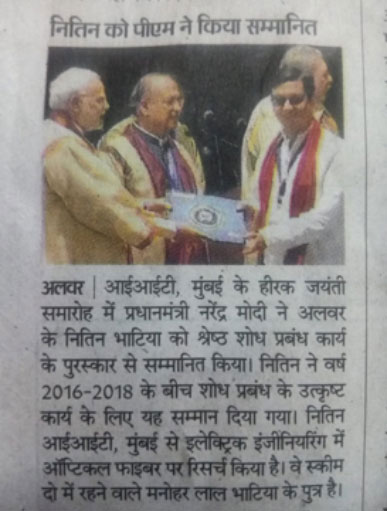Dr. Nitin Bhatia Doctoral Work Receives ‘Excellence in Ph.D. Research’ Award of IIT Bombay

Dr. Nitin Bhatia, Faculty in the Electronics & Communication Engineering Area at NU received the prestigious ‘Excellence in Ph.D. Research’ Award of IIT Bombay from Prime Minister Shri Narendra Modi, on 11th August 2018.
Dr. Nitin Bhatia received his doctorate from the Department of Electrical Engineering, IIT Bombay in 2016. His research work pertains to the broad field of Fiber Optics and Photonics. His expertise is on fiber based multimode interference devices which find various applications ranging from optical sensors, all-fiber passive devices, and fiber lasers. He is currently working to realize optical fiber based solutions for generating Bessel, Vector, OAM and LG optical beams for medical imaging and communication systems.


His achievement also found a mention in the print media.

Exciting a single mode in a multimode fiber (MMF) is desirable for a variety of applications such as generation of Bessel-like beams, higher order mode fiber lasers and amplifiers, and high speed data communication systems. Bessel-like beams are important due to their diffraction-free nature as compared to similar Gaussian beams.
In his thesis, a Single mode – Multimode – Multimode (SMm) fiber structure is proposed for exciting a single radial mode (LP0,n) in an MMF. The device requires just a small section of a larger core MMF sandwiched between an SMF and a smaller core MMF. For developing a physical understanding of the device functioning, the theory of Multimode Interference (MMI) is employed with the analysis of propagating eigenmodes. The SMm structure exploits the modal interference phenomenon for an entirely different purpose. The interfering modes of the central MMF are utilized for generating an optimum launching field for exciting a single LP0,n mode in the output MMF. The SMm design process gives a modal purity ranging between 90−100% in the output MMF. This means that the power propagating in the excited mode is ≥ 90% of the total power in all the modes. The SMm device is designed not only for exciting the well confined lower order LP0,n modes but also the highest possible mode of the fiber which is nearest to the cut-off condition.
NU congratulates Dr. Nitin Bhatia and looks forward to more exciting and groundbreaking work from him!




